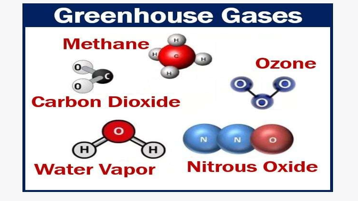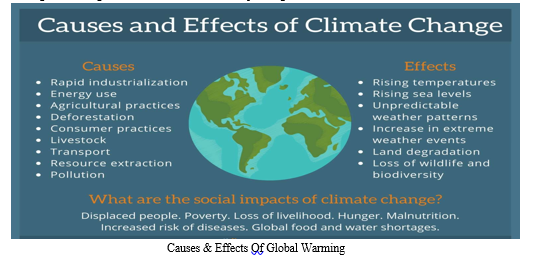Ijraset Journal For Research in Applied Science and Engineering Technology
- Home / Ijraset
- On This Page
- Abstract
- Introduction
- Conclusion
- References
- Copyright
A Global Warming and Climate Change is a Major Threat to the Earth and Environment in the Near Future
Authors: Shubham Bangar
DOI Link: https://doi.org/10.22214/ijraset.2023.56030
Certificate: View Certificate
Abstract
This review article presents compelling evidence that global warming has already begun, and it requires our immediate attention. The accumulated evidence of significant and alarming climate changes on Earth has rapidly grown, especially in the last three decades. Rather than relying primarily on theoretical models, the reality of global warming is supported by an extensive body of observations from various sources. The focus of climate research has shifted from proving global warming\'s existence to understanding its causes. While it may be challenging to predict the exact extent of damage from global warming, it is clear that its harmful effects on the climate will far outweigh any potential benefits. There is a high probability that human-generated greenhouse gases, particularly carbon dioxide, are the primary drivers of documented global warming and climate change. It is emphasized that much can be done now to mitigate the effects of global warming and associated climate change. The main obstacles in addressing this issue are not the unavailability of technology but the lack of sufficient incentives to implement these technologies more aggressively. This highlights the need for policy measures and collective efforts to tackle the challenges posed by global warming effectively.
Introduction
I. INTRODUCTION
Throughout history, humans have influenced the environment, but it wasn't until the industrial revolution that our actions began to impact the entire planet. Today, environmental concerns have become a top global priority, driven by scientific evidence showing an increase in greenhouse gases in the atmosphere and resulting shifts in the Earth's climate. In a report by the Intergovernmental Panel for Climate Change (IPCC) indicated that the population of insects is expected to increase around the world due global warming/rise in temperature. Temperature regulates insects’ physiology and metabolism. An increase in temperature increases physiological activity and, therefore, metabolic rates. Insects must eat more to survive and it’s expected that insect herbivores will consume more and grow faster. This will lead to increases in the population growth rate of certain insects. Because they grow fast they’ll reproduce more. Their numbers will multiply and this will ultimately lead to more crop damage.[1]
Worldwide, temperatures are climbing, and precipitation patterns are changing. This phenomenon, known as global warming and climate change, transcends borders and is primarily caused by the ongoing release of greenhouse gases, which trap heat in the Earth's atmosphere, leading to a warming effect.
Since the industrial era began, the Earth's temperature has already gone up by 0.7 degrees Celsius. Without immediate intervention, by 2100, temperatures could rise by as much as 5 degrees Celsius. Such a temperature increase would bring devastating consequences, including more frequent extreme weather events and the further endangerment of numerous plant and animal species.
Human activities have introduced greenhouse gases into the atmosphere. Carbon dioxide (CO2) mainly results from activities like deforestation and burning fossil fuels. Methane (CH4) and nitrous oxide (N2O) emissions arise from agricultural practices and waste management. Additionally, industrial processes release fluorinated gases. All of these additional greenhouse gases contribute to an intensified greenhouse effect.[2] Measurable increases in greenhouse gas concentrations have occurred since the industrial revolution. CO2 levels have risen by roughly 30% since 1750, N2O by around 50%, and CH4 has approximately doubled. Continued fossil fuel burning and changes in land use continue to release larger quantities of these gases into the atmosphere. These greenhouse gases, which include carbon dioxide (CO2), methane (CH4), and nitrous oxide (N2O), trap more of the sun's heat within Earth's atmosphere than would typically escape into space. This heightened heat retention leads to the greenhouse effect and the resulting climate changes we are experiencing.
The report reinforces the scientific view that CO2 is the primary GHG and needs to be drastically reduced. The report mentions that for every 1000 GtCO2 emitted by human activity, global surface temperature rises by 0.45°C (best estimate, with a likely range from 0.27 to 0.63°C). The remaining carbon budgets from the beginning of 2020 are 500 GtCO2 for a 50% likelihood of limiting global warming to 1.5°C and 1150 GtCO2 for a 67% likelihood of limiting warming to below 2°C. Reaching net zero CO2 or GHG emissions primarily requires deep and rapid reductions in gross emissions of CO2, as well as substantial reductions of non-CO2 GHG emissions. Climate justice and equity are important enablers for ensuring climate action and growth and development for developing countries. The Report notes that modelled scenarios explore only a limited number of solutions, and warns against mistaking them for predictions or forecasts. The scientists also confirm that models do not explicitly account for equity, environmental justice, and income distribution - all crucial factors in climate policy decision.[3]
The Government has been assessing climate change over the years through various Ministries and Agencies. The India Meteorological Department (IMD) brings out the publication ‘Annual Climate Summary’ at the end of every year that features highlights of climate patterns and long-term changes since the year 1901 in all-India temperature and rainfall at annual and seasonal scales. Climate change is a global collective action problem. As per the Intergovernmental Panel on Climate Change (IPCC) The Working Group I contribution to the Sixth Assessment Report titled, “Climate Change 2021: The Physical Science Basis”, global warming of approximately 1.07°C has already occurred in the decade 2010-2019 since 1850-1900.According to the Ministry of Earth Sciences, the surface air temperature over India has risen by about 0.7°C during 1901–2018.
Reports from various sources including IPCC highlight that the challenges faced due to global warming are mainly due to cumulative historical and current greenhouse gas emissions of the developed countries. India with more than 17 % of global population has contributed only about 4 % of the global cumulative greenhouse gas emissions between 1850 and 2017.[4]
II. CLIMATE CHANGE & GLOBAL WARMING SOURCES
- Increase in Greenhouse Gases and Temperature
- Carbon dioxide (CO2), a significant human-caused greenhouse gas, has risen from pre-industrial levels of 280 ppm to 379 ppm in 2005, well beyond natural levels.
- Methane (CH4) in the atmosphere has increased from 715 ppb to 1774 ppb in 2005, significantly exceeding natural ranges.
- Nitrous oxide (N2O) has gone up from 270 ppb to 319 ppb in 2005.
- Human activities, mainly related to fossil fuels and agriculture, are the primary drivers of these increases.

B. Evidence of Climate Change
- Climate warming is undeniable, with 11 of the last 12 years (1995–2006) being among the warmest since 1850.
- A robust linear warming trend of 0.74°C (1906 to 2005) surpasses the trend for 1901 to 2000.
- Over the past 50 years, the warming trend of 0.13°C per decade is nearly double that of the last century.
C. Warming Oceans:
- Global ocean temperatures have warmed to at least 3000 meters since 1961, with over 80% of the added heat absorbed by the ocean.
- This warming leads to seawater expansion, contributing to rising sea levels.
D. Melting of Glaciers and Snow
- Mountain glaciers and snow cover have decreased in both hemispheres.
- Melting from the Greenland and Antarctic ice sheets contributes to rising sea levels.
E. Sea Level Rise
- Global sea levels rose at an average rate of 1.8 mm per year from 1961 to 2003, accelerating to 3.1 mm per year from 1993 to 2003.
- There is strong confidence that sea level rise increased from the 19th to the 20th century.
- Sea-level rise in the North Indian Ocean occurred at a rate of 3.3 mm per year in the last two and half decades (1993-2017) [5]
F. Decline in Arctic Ice
- Arctic sea ice extent has decreased by 2.7% per decade since 1978, with more substantial declines in summer.
- Arctic temperatures increased almost twice as fast as the global average over the last century.
G. Changes in Precipitation
Long-term precipitation trends from 1900 to 2005 reveal increased rainfall in some regions and drying in others.
Precipitation trends vary widely, with regions like North and South America, northern Europe, and northern and central Asia experiencing increased rainfall.
These findings provide robust evidence of climate change driven by rising greenhouse gas levels, ocean warming, ice melt, sea level rise, and shifts in precipitation patterns.
III. IMPACT OF GLOBAL WARMING ON DIFFERENT SECTOR
A. Melting of Glaciers
The melting of glaciers around the world is a major concern. It can lead to flooding followed by droughts in the near future. This will result in water scarcity, affecting both society and agriculture due to increased moisture loss through evapotranspiration and higher demand for drinking water, industry, and irrigation. Rising sea levels and water expansion could also lead to the loss of coastal biodiversity, particularly mangrove ecosystems that protect coastlines. In Kashmir, for example, the Kohlai glacier has shrunk by approximately 5% since 1960, and river water levels have decreased by 40% over the last 40 years.
B. Impact on Agriculture
Climate change poses significant threats to global agricultural production. Food security is a top concern when it comes to human activities and ecosystem services affected by climate change. While elevated carbon dioxide (CO2) levels can benefit crops, the associated factors of increased temperatures, altered precipitation patterns, and more extreme events like droughts and floods are likely to reduce yields and increase production risks globally. Developing countries, in particular, are vulnerable due to their reliance on agriculture, limited capital for adaptation, warmer climates, and exposure to extreme events. This vulnerability could have serious consequences in regions where millions of people are already undernourished, such as sub-Saharan Africa.[6]
C. Factors Affecting Agriculture
Climate change impacts agriculture by altering the optimal climate conditions for crop and livestock production. Factors like soil quality and water availability play crucial roles. Poor soil and insufficient water can limit crop growth and productivity. Plants are adapted to specific temperature and humidity ranges for optimal yields. Increasing temperatures and rising CO2 levels can affect the rate of plant development and, consequently, the growing period. For example, a 1% increase in the growing season mean temperature between 30-40°C can reduce rice productivity by 10%. Wheat productivity can decrease by 3-4% per 1°C rise in atmospheric temperature. High temperatures can negatively impact reproductive organs like pollen spikelets while stimulating the growth of vegetative organs like leaves and stems. Wheat and rice are most sensitive to high temperatures during anthesis, leading to sterility. Global warming may threaten the cultivation of certain crops in Central India and Northern India, including temperate fruits like cherry, apple, plum, and peach. It could also impact endemic crops like Basmati rice and litchi. The balance of food trade may shift, with positive impacts on Europe and North America but negative impacts on tropical and subtropical countries like India, Brazil, and Mexico.
In summary, the consequences of global warming are far-reaching and affect various aspects of our environment, including glaciers, agriculture, and coastal ecosystems. These impacts pose significant challenges, particularly for vulnerable regions and food security. Adaptation and mitigation strategies are crucial to address these pressing issues.

Conclusion
The current imperative is for proactive government involvement in tackling this issue. To prompt meaningful action from businesses and industries, it\'s essential that both the government and stakeholders fully commit to addressing climate change. The pace at which we can combat global warming and its effects largely depends on public demand and government responsiveness. We believe that the speed at which we can address the challenges of global warming and climate change will be determined by public sentiment and the government\'s response to those sentiments. Considering the numerous opportunities for profitable entrepreneurial endeavors across various levels, there\'s no reason why both liberal and conservative policymakers cannot find solutions to these problems, provided the public demands it. It appears that we face a significant dual challenge in terms of education and politics. Hopefully, future generations will recognize that our decisions were the right ones.
References
[1] IPCC (05 APR 2023). Climate Change: The physical science basis. Minister for State (Independent Charge) for Ministry of Science and Technology and Earth Sciences, Dr. Jitendra Singh in Lok Sabha. [2] UNFCCC (2009). Climate Change: impacts, vulnerabilities and adaptation in developing countries. [3] IPCC (March, 2023) AR 6 Synthesis Report.IPCC-58th Session for Synthesis Report Approval, Interlaken, Switzerland. [4] IMD (DEC 2021) Assessment of the impact of global warming. Shri Ashwini Kumar Choubey, Minister of State, Ministry of Environment, Forest & Climate Change in Rajya Sabha [5] Ministry of Earth Sciences (MoES). (JULY 2023). Assessment of Climate Change over the Indian Region. [6] Mendelsohn, R. & Dinar, A. (2009). Climate change and agriculture: An economic analysis of global impacts, adaptation and distributional effects. Northampton, MA: Edward Elgar Publishing, Inc
Copyright
Copyright © 2023 Shubham Bangar. This is an open access article distributed under the Creative Commons Attribution License, which permits unrestricted use, distribution, and reproduction in any medium, provided the original work is properly cited.

Download Paper
Paper Id : IJRASET56030
Publish Date : 2023-10-06
ISSN : 2321-9653
Publisher Name : IJRASET
DOI Link : Click Here
 Submit Paper Online
Submit Paper Online

